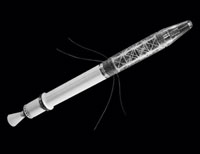US celebrates 50th anniversary of its first satellite launch
31 Jan 2008
 On 31 January 1958, a small group of rocket scientists and engineers awaited the outcome of a rocket launch, which took a US satellite, Explorer 1, into orbit. The signal from the satellite came in eight minutes behind schedule, announcing to the anxious group that all was well. The sounding of its beep marked the commencement of a frenetic space race between the USA and the erstwhile Soviet Union that also resulted in amazing achievements for the scientific community and mankind in general.
On 31 January 1958, a small group of rocket scientists and engineers awaited the outcome of a rocket launch, which took a US satellite, Explorer 1, into orbit. The signal from the satellite came in eight minutes behind schedule, announcing to the anxious group that all was well. The sounding of its beep marked the commencement of a frenetic space race between the USA and the erstwhile Soviet Union that also resulted in amazing achievements for the scientific community and mankind in general.
It was the launch of the Soviet satellite, Sputnik, a few months earlier, that galvanised the USA into designing and launching its own satellite. The shock of the Soviet success resulted in the United States government handing a 90-day deadline to the US Army and to an unknown research establishment, the Jet Propulsion Lab (JPL), to design and send up its own satellite.
The project was completed in a record time of 84 days, marked by the launch of the Explorer 1 on 31 January 1958.
The launch also marked the debut of a little known research lab based in Pasadena, California, the Jet Propulsion Lab (JPL). The lab has since established itself as one of the premiere space research and applications institutions in the US and the world.
The Flopnik
The US Army and the Jet Propulsion Laboratory met the near-impossible deadline by reviving parts and pieces from a project that had been mothballed earlier - Project Orbiter.
This was a project to put a satellite into orbit, which the US Army lost out to the US Navy in 1955. On losing the competition to the US Navy, the Army tried to re-design the rocket as an IRBM, but without any support from the Dept of Defence, eventually mothballed the project.
Meanwhile, two months after the Sputnik launch, the US Navy's attempt to launch a satellite failed when its rocket engine lost power in flight and exploded on the way down. This prompted American newspapers to dub it the "flopnik."
Lasting glory
The US Army and the JPL then modified the rocket, being developed for Project Orbiter earlier, by putting on a new fourth-stage motor. The bullet-shaped satellite, Explorer 1, was designed from scratch.
The triumvirate of William Pickering, James Van Allen and the WWII scientist from Nazi Germany, Wernher von Braun, headed the project. While the Army modified the rocket, JPL designed the payload, which had an instrument to detect cosmic rays.
It was this instrument that discovered the radiation belt around the Earth.
Explorer 1 sent back its last signal in 1958 and finally burned up on re-entry into the atmosphere in 1970, after making more than 58,000 loops around Earth.
The launch of Explorer 1 eventually led to many spectacular achievements and failures in space. The JPL, since then, also transformed itself from a military weapons lab into a civilian robotics centre, which is now a part of NASA and run by the California Institute of Technology.













.jpg)






.jpg)









